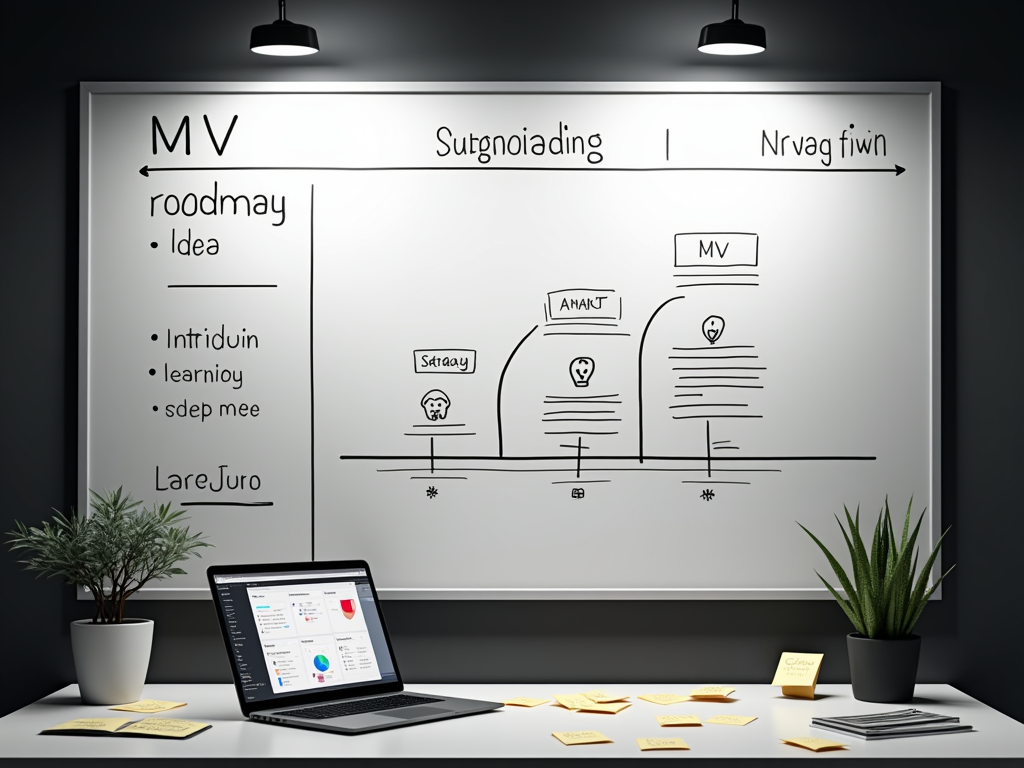Building a Market-Ready MVP: Your Guide to Product-Market Success
Building a Market-Ready MVP: Your Guide to Product-Market Success

Introduction
Starting with a powerful statistic about successful MVPs, this intro will explore why many MVPs fail to gain traction and how strategic planning can lead to market success. We’ll highlight Startup OG’s expertise in helping founders build sustainable, customer-focused products.
Understanding the Core Elements of a Sellable MVP

Building a successful startup requires more than just a good idea—it demands a strategic approach to product development. Understanding the core elements of a sellable MVP can mean the difference between market success and failure. According to CB Insights, 42% of startups fail because they create products that nobody wants. Let’s explore what truly makes an MVP not just viable but sellable in today’s competitive landscape.
Defining the Critical Difference Between a Prototype and a Market-Ready MVP
Many founders confuse prototypes with MVPs, which leads to costly mistakes. A prototype is simply a working model that demonstrates functionality, while a market-ready MVP is a strategically crafted product designed to solve specific customer problems.
The key distinction lies in the intent: prototypes are built to test technical feasibility, while sellable MVPs are created to validate business assumptions and generate real customer feedback. Your MVP must include enough features to deliver genuine value while remaining lean enough for quick iterations.
Consider the difference:
For Indian entrepreneurs, this distinction is particularly important given market sensitivities to pricing and value perception. A sellable MVP in the Indian context must demonstrate clear utility and address local needs rather than simply mimicking western products.
When building your MVP, ask yourself: “Can this product, in its current state, genuinely solve a problem someone would pay for?” If not, you likely have a prototype, not an MVP.
Identifying Your Target Market’s Most Pressing Pain Points
The foundation of any sellable MVP is a deep understanding of customer pain points. Many startups fail because founders build products based on assumptions rather than validated customer needs.
Start by conducting comprehensive customer research:
For Indian founders, this might mean recognizing unique challenges in your local market. For example, if your target audience faces internet connectivity issues, your MVP should function well with intermittent connectivity.
Document all pain points and rank them by:
This prioritization helps you focus your MVP on solving the most critical problems first. Remember that solving one problem exceptionally well is better than addressing multiple problems inadequately.
Establishing Clear Success Metrics Before Development Begins
Without defined success metrics, you can’t objectively determine if your MVP is working. Before writing a single line of code, establish specific, measurable criteria for success.
Your metrics should align with your business goals and include:
User Engagement Metrics:
Business Metrics:
Product Metrics:
For Indian startup ecosystems, where capital efficiency is often crucial, metrics around cost-effective customer acquisition and resource utilization may carry extra weight.
Set specific targets for each metric with timeframes. For example: “Achieve 20% week-over-week user growth for the first 8 weeks after launch” or “Maintain a 40% retention rate after 30 days.”
These metrics will not only help you evaluate your MVP’s performance but also provide valuable data points when speaking with potential investors or partners.
Understanding the core elements of a sellable MVP fundamentally changes how you approach product development. By differentiating between prototypes and MVPs, identifying genuine customer pain points, and establishing clear success metrics, you position your startup for validation and growth in the market rather than building in isolation.
Validating Your MVP Concept Before Building

According to CB Insights, 42% of startups fail because they build products nobody wants. Validating your MVP concept before investing time and resources into development isn’t just a good practice—it’s essential for survival in today’s competitive startup landscape.
Validation helps you confirm whether your solution addresses a genuine problem that people are willing to pay for. This critical step can save you months of development work and significant capital that might otherwise be wasted on an unwanted product.
Effective Methods for Gathering Meaningful Customer Feedback
Customer feedback is the lifeblood of product validation. Without it, you’re simply guessing what your market wants.
Start by identifying your target customers precisely. For Indian entrepreneurs, this might mean focusing on specific demographic segments based on location, income level, or technological literacy. Be as specific as possible about who will benefit from your solution.
Direct interviews remain one of the most valuable feedback methods. Aim to conduct 15-20 in-depth conversations with potential users. These interviews should focus on understanding their problems rather than pitching your solution.
Some key questions to ask include:
Prototype testing provides concrete feedback. Create simple mockups using tools like Figma or even paper sketches to visualize your concept. Watch how potential users interact with these prototypes and note where they get confused or excited.
Landing page tests can validate demand before building anything. Create a simple page describing your proposed solution with a signup form or “pre-order” button. Direct targeted traffic to this page through social media or Google ads. A high conversion rate suggests genuine interest.
Remember to document all feedback systematically. Look for patterns rather than isolated opinions, and pay special attention to emotional reactions during feedback sessions.
Creating Assumption Maps to Test Product Viability
Every MVP concept is built on assumptions that need verification. Mapping these assumptions explicitly helps prioritize what to test first.
Start by listing all your business and product assumptions. For example:
Categorize assumptions based on importance and uncertainty:
For each critical assumption, design a specific test. For example, to test pricing assumptions, you might offer different pricing tiers on your landing page to see which converts best.
Set clear success criteria for each test before starting. What conversion rate would validate your assumption? What feedback patterns would confirm your hypothesis?
Use a simple tracking system—even a spreadsheet works—to monitor assumptions as they move from “unverified” to either “confirmed” or “disproven.” When critical assumptions fail validation, be prepared to pivot your concept rather than proceeding with a flawed premise.
This systematic approach to testing assumptions helps Indian founders make evidence-based decisions rather than relying on gut feelings or market reports that might not reflect local realities.
Using Competitive Analysis to Find Your Unique Market Position
The Indian startup ecosystem is growing rapidly, making competitive analysis crucial for finding your niche. Understanding the competitive landscape helps identify opportunities that others have missed.
Begin by identifying direct and indirect competitors. Direct competitors solve the same problem you’re targeting, while indirect competitors offer alternative solutions to the same need.
For each competitor, analyze:
Look for patterns across competitors. Are they all focusing on enterprise clients while neglecting SMEs? Are they all solving one aspect of the problem while ignoring others?
Create a positioning map placing competitors on axes representing key differentiating factors relevant to your market. This visual representation helps identify white space opportunities—areas where customer needs remain unaddressed.
Don’t just look at weaknesses to exploit. Study what competitors are doing right and learn from their successes. This might mean adapting proven business models to new market segments or combining successful elements in unique ways.
For Indian startups, local market knowledge often provides a competitive edge. International solutions may not account for uniquely Indian challenges around payment preferences, multilingual needs, or connectivity limitations.
Document your unique value proposition based on this analysis. Your MVP should focus on delivering this core differentiation excellently, even if it means offering fewer features initially.
Validating your MVP concept through customer feedback, assumption testing, and competitive analysis significantly increases your chances of building something truly valuable. While this validation process requires patience, it ultimately accelerates your path to product-market fit by ensuring you’re solving the right problem in the right way.
Developing Your MVP with Sales in Mind

Creating a Minimum Viable Product (MVP) is a critical milestone for any startup. But developing an MVP that actually sells requires strategic thinking from day one. At Startup OG, we’ve observed that founders who align product development with sales strategies achieve market fit faster. Developing your MVP with sales in mind isn’t just smart—it’s essential for survival in India’s competitive startup ecosystem.
Focusing on Core Features That Directly Address Customer Needs
The most successful MVPs aren’t packed with features—they solve specific problems exceptionally well. Start by identifying your customers’ most pressing pain points through thorough market research.
Indian entrepreneurs often fall into the feature-bloat trap, adding unnecessary complexities that delay launch and confuse early users. Instead, prioritize the 2-3 core functionalities that directly solve your target market’s primary challenges.
For example, when Zerodha launched, they focused exclusively on discount broking rather than trying to compete with established players across all services. This laser focus on a core need—affordable trading—helped them capture market share rapidly.
Use these practical steps to identify core features:
Remember, each additional feature increases development time and costs. A simple product that solves one problem perfectly will outperform a complex solution that addresses many problems inadequately.
Implementing Feedback Loops During Development
Building in isolation is a recipe for market rejection. Smart founders create continuous feedback mechanisms throughout the development process.
Set up structured feedback cycles with potential customers at multiple stages:
Effective feedback loops require asking the right questions. Don’t just ask if users “like” your product—dig deeper with questions about specific use cases, frequency of use, and willingness to pay.
Indian startup Freshworks (formerly Freshdesk) credits their early success to rapid iteration based on customer feedback. They released new versions every three weeks, incorporating user suggestions that directly improved core functionality.
Building these feedback mechanisms doesn’t require complex systems. Simple tools like Google Forms, WhatsApp groups with beta users, or regular Zoom calls with early adopters can provide invaluable insights.
Building a Pricing Strategy That Reflects Market Value
Many technical founders delay pricing decisions until after building the product—a critical mistake. Your pricing strategy should evolve alongside your MVP development.
Understanding what customers will pay helps you:
When developing pricing for the Indian market, consider these factors:
Testing different price points early can provide surprising insights. Razorpay, a leading Indian payment gateway, discovered that their initial pricing was actually too low, causing potential enterprise customers to question their reliability.
Consider implementing a tiered pricing structure even with your MVP. This allows you to capture different segments of the market while learning which features are most valuable to different user types.
Your MVP pricing doesn’t need to be your final approach. Many successful Indian startups have used introductory pricing to gain traction, then adjusted based on market feedback and feature additions.
Developing your MVP with sales in mind means creating a product that not only works technically but also resonates with market needs and pricing expectations. This approach significantly increases your chances of gaining traction in India’s dynamic startup ecosystem.
Testing and Launching Your MVP Strategically

The journey from MVP concept to market introduction represents a critical juncture for startups. At Startup OG, we’ve observed that effectively testing and launching your MVP strategically can mean the difference between sustainable traction and premature scaling. This methodical approach ensures your product meets genuine market needs before committing significant resources to full-scale development.
Creating a Pre-launch Validation Checklist
Before your MVP meets the world, comprehensive validation is essential. A structured pre-launch checklist serves as your quality control mechanism and confidence builder.
Start by documenting all core functionalities that require testing. These should directly connect to the key value propositions your MVP promises to deliver. Remember to prioritize testing features that solve your target audience’s most pressing problems.
Your validation checklist should include:
- User interface assessment – Verify navigation paths are intuitive and follow logical flows
- Core functionality verification – Test that primary features work as intended across different devices and browsers
- Payment processing validation – Run multiple transaction scenarios to ensure smooth completion
- Data security compliance – Confirm proper encryption and privacy measures are implemented
- Performance testing – Check loading times and response rates under various user loads
Don’t overlook technical debt assessment. Document necessary future improvements while maintaining focus on your MVP’s core promise. This balanced approach prevents feature creep while acknowledging future development needs.
Many founders rush this validation phase, but patience here pays significant dividends. Establish clear pass/fail criteria for each checklist item to maintain objectivity during assessment.
Developing a Soft Launch Strategy to Gather Initial Sales Data
The soft launch represents your MVP’s first controlled exposure to real market conditions. This strategic phase provides valuable insights while minimizing potential reputation damage from early-stage imperfections.
Begin by identifying your ideal first customers. These early adopters should be more forgiving of minor issues while providing constructive feedback. In the Indian context, targeting tech-forward urban professionals or specific industry verticals can provide focused initial response data.
Structure your soft launch in phases:
- Friends and family testing – Gather feedback from your immediate network
- Limited geographic release – Target specific cities or regions in India
- Controlled user count – Cap initial registrations to manage support demands
- Gradual feature rollout – Introduce advanced features sequentially
Set measurable goals for each soft launch phase. Define specific metrics for success beyond vague targets like “positive feedback.” Consider conversion rates, usage frequency, and specific feature engagement.
Create compelling but realistic incentives for early adoption. Early access, founding member status, or limited-time pricing can drive initial uptake without setting unsustainable expectations.
Remember to balance enthusiasm with realistic timelines. Indian entrepreneurs often face unique market challenges that may extend testing phases beyond initial projections.
Setting Up Systems to Track Customer Behavior and Feedback
Developing robust tracking mechanisms transforms anecdotal impressions into actionable data. These systems help identify patterns that might otherwise remain hidden in individual user experiences.
Implement analytics tools appropriate to your product category and budget constraints. While premium solutions offer comprehensive insights, many startups can begin with free tools like Google Analytics, complemented by feedback collection mechanisms.
Essential metrics to track include:
- Activation rates – The percentage of users who complete key onboarding actions
- Retention patterns – How often and for how long users return to your product
- Feature utilization – Which capabilities receive the most and least attention
- Conversion points – Where prospects transform into paying customers
- Drop-off locations – Specific points where users abandon your product
Beyond quantitative data, establish multiple feedback channels. In-app surveys, feedback widgets, and direct outreach to power users can reveal qualitative insights that numbers alone might miss.
Create a systematic process for feedback collection and implementation. Document user suggestions, prioritize them based on frequency and strategic alignment, and communicate changes back to users who provided input.
Testing and launching your MVP strategically requires balancing structured methodology with flexibility. The insights gained during this phase will inform not just immediate improvements but fundamental strategic decisions about your product’s future direction.
Optimizing Your MVP Based on Market Response

A staggering 42% of startups fail because they build products nobody wants. This sobering statistic underscores why optimizing your Minimum Viable Product (MVP) based on actual market response isn’t just beneficial—it’s essential for survival. When you launch your MVP into the market, you’re conducting a real-world experiment that provides invaluable insights no amount of planning can replicate.
Analyzing Early Adoption Patterns and User Behavior
The initial weeks after your MVP launch reveal critical patterns that can determine your startup’s trajectory. Start by establishing clear baseline metrics to track user interactions with your product. These might include:
- Daily and monthly active users
- User retention rates
- Feature usage frequency
- Time spent on different sections
- Conversion points and drop-offs
Don’t just collect data—digest it properly. Use heat maps to identify which features attract the most attention and which get ignored. For Indian startup founders, understanding regional preferences is particularly important, as user behavior can vary significantly across different states.
One effective approach for analyzing user behavior is the “5 Whys” technique—drilling down to root causes behind user actions. When users abandon your product after the signup page, ask why five times to uncover the underlying issue. Is it a confusing interface? Too many form fields? Cultural barriers?
Look for behavioral cohorts—groups of users who follow similar patterns. These patterns often reveal unexpected use cases for your product. Many successful startups, including Slack, discovered their true value proposition by paying attention to how early adopters actually used their product, not how they intended it to be used.
Implementing Quick Iterations Based on Customer Feedback
Speed matters when optimizing your MVP. The ability to implement changes quickly based on customer feedback creates a competitive advantage. This is where the “build-measure-learn” loop becomes crucial.
First, establish multiple feedback channels:
- In-app surveys (keep them under 3 questions)
- User interviews (aim for 5-7 per week)
- Usage analytics
- Support ticket analysis
- Social media monitoring
Prioritize feedback using the Impact-Effort matrix. Plot each potential change on two axes: impact on user experience and effort required to implement. Focus on high-impact, low-effort changes first—these give you quick wins that maintain momentum.
For Indian entrepreneurs working with limited resources, this prioritization becomes even more critical. You can’t address everything, so focus on the 20% of issues that cause 80% of user frustration.
Create a structured iteration schedule—perhaps bi-weekly sprints—to keep the optimization process organized without falling into analysis paralysis. Document each iteration with clear hypotheses: “We believe changing X will result in Y improvement.”
Remember that negative feedback provides more actionable insights than positive comments. When users complain about specific features, they’re telling you exactly what needs fixing.
Scaling Features Based on Validated Market Demand
The final step in optimizing your MVP is making intelligent decisions about which features to scale, maintain, or cut. This process prevents feature bloat while ensuring you invest resources in areas that actually drive user value.
Start by categorizing features into three buckets:
- Must-haves: Features driving core value and retention
- Performance enhancers: Features improving the experience but not essential
- Delighters: Features creating positive emotional responses but not expected
This framework, inspired by the Kano model, helps you make tough decisions about where to focus. For instance, if user data shows that 85% of retained users engage with a specific feature, that’s a strong signal to invest in scaling and improving that feature.
Be willing to cut features that data shows aren’t providing value—even if you personally love them. Many Indian startups fail because founders become emotionally attached to features users don’t actually need.
When validating market demand for new features, use techniques like fake door testing—where you create the appearance of a feature to gauge interest before building it. This approach is particularly valuable for bootstrapped founders looking to conserve resources.
Optimizing your MVP based on market response requires balancing quantitative data with qualitative insights. Numbers tell you what’s happening, but user conversations tell you why. By mastering this balance, you’ll create a product that genuinely solves real problems for your target market.
Conclusion
Wrap up with key takeaways about building market-ready MVPs, emphasizing Startup OG’s role in supporting founders through the development process.
Join the Startup OG community for personalized guidance and access to valuable resources for sustainable startup growth.